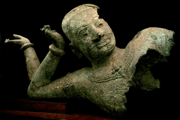Khmer bronze production began from the Neolithic
period (5,000BCE) and reached its apogee during the Angkor period
(Baphuon style). The technique used continuously until the present-day
is the ‘cire-perdue’ or ‘lost-wax ’ process.
Some statues were inlaid in the eye cavities with precious stones
to make them more life-like. The art of inlay was undeniably widespread
throughout Southeast Asia in the 11th century.
This reclining Visnu is testimony to the talent of Khmer artists
in the production of monumental bronze statues. Fragments of this
statue were found in 1936 during excavations of a platform at
the Western Mebon temple and were brought to the National Museum
on the 1 December 1950.
The deity is in the attitude of reclining on the ocean, represented
by the vast reservoir (baray) at Angkor (8km east to west and
2km north to south), constructed by King Udayadityavarman II (1050-1066).
Helen I. Jessup wrote, “The god reclined on the serpent
Ananta (without end), who was floating on the ocean during one
of the cosmic intervals or kalpa … According to Vedic myth,
Visnu, Ananta and ocean are all aspects of the same reality, parts
of the primordial waters where gods give rise to the universe”.
Visnu is the preserver of the world. This colossal statute was
created by the king to safeguard the city of Angkor. The figure
is represented with four arms: the left are broken, while one
of the right arms supports the head.
The stern facial expression and the head resting on the hand
highlight his contemplation of the city. This adorned Visnu is
decorated with accessories that include armbands, bracelets and
a pectoral collar, which was considered a traditional motif in
Khmer decorative art. This collar motif is round and has a large
rosette in the centre. It is decorated with pendants at the back.
The hollows of the eyes and above the lips prove the ancient Khmer
artists used precious stones and metals for inlay.
Despite its fragmented appearance, this statue reveals the power
of the king in ancient Cambodia and the excellence of metal casting
techniques.


